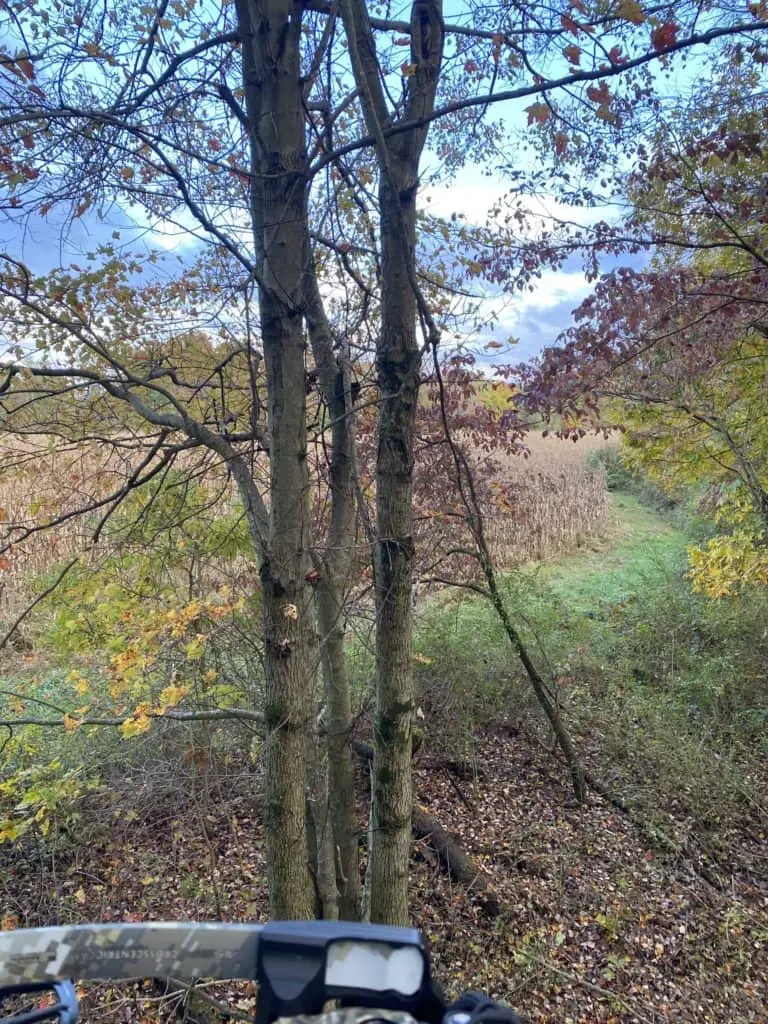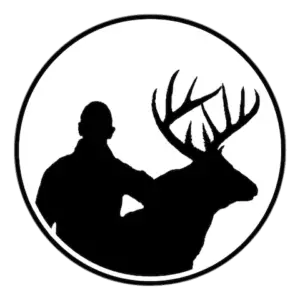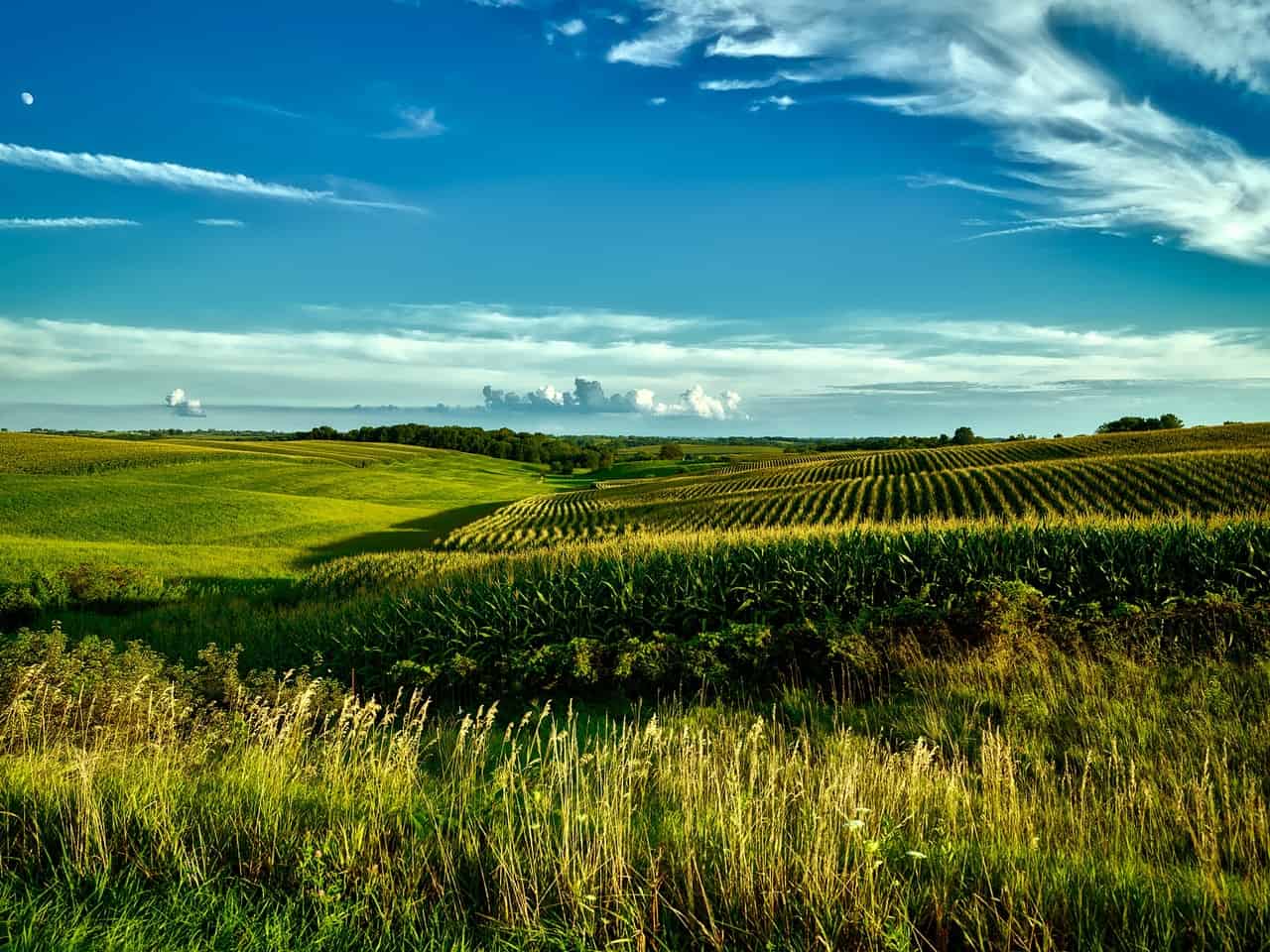Yes, deer bed in standing cornfields. Safety and food are priorities for every deer and cornfields offer both. Hunters kill bedded deer in the corn every year and farmers have been known to get deer stuck in their combines when harvesting corn. Hunting deer that are bedded down in corn is one of the most underutilized and most effective strategies for killing deer.
Why deer bed in standing corn
Deer bed down in standing corn mostly for one reason, safety. Think about how you would hide if you were being hunted. The last place you would want to be is out in the open. So maybe you would hide in the woods where it’s less likely to be seen. However, the woods still pose a threat because visibility is still a factor especially if you need to move around.
Deer know that their odds of seeing coyotes, humans, ATV’s, etc, are going to be much higher in open woods than if they were in an area of dense cover. Deer want a feeling of safety and standing corn offers a higher level of safety than the woods can offer. Deer are in their most relaxed state in areas where predators are the least likely to be, and that includes humans. In most cases the thicker the cover, the more a deer will feel safe and relaxed. I’m sure standing corn is one of many reasons that big bucks are able to go season to season without getting killed. If you are having a hard time seeing a buck during daylight and you have a good feeling that he is bedding in the corn then you might want to consider trying to find that buck in the corn and make a stalk on him.
How to locate deer in standing corn
If you hunt in a state in the Midwest then it might seem like finding a bedded deer in corn is like finding a needle in a haystack. However, there are some strategies that make this style of hunting very effective.
First, you probably aren’t going to cover every inch of a cornfield unless the field is small enough to do so. There are certain areas that deer are going to be using more frequently than others. Typically these areas are going to be close to, or between, other habitat features such as woods or a grassy thicket. Hopefully you have a history with how the deer move throughout the landscape in your area. If you don’t, one of the best strategies for learning where the deer are at within the corn is by asking the local farmers. You could also ask a farmer for permission to hunt a standing cornfield. The success of you getting permission to hunt someone’s cornfield is probably more likely than you getting access to hunt their woods.
Once you have a general idea where the deer are going to be in the corn, get an idea of how deer are going in and out of the corn. Walk around the perimeter of the cornfield looking for tracks on the ground. This is something that you should do days, weeks, or months before going after deer in the corn. If you plan to scout and hunt on the same day, pay special attention to the wind direction. Don’t let your wind blow towards where you expect the deer to be because they will be more alert, making your hunt difficult or possibly spooking those deer away completely. Once you have picked out the area of standing corn that you plan to hunt, it’s time to go in after the deer.

How to kill deer in standing corn
Plan the attack
The number one rule for trying to shoot a deer bedded down in standing corn is that you need to hunt them on a windy day. The wind needs to be at least 10 mph or more. The higher the wind speeds, the better. Windy weather is going to blow the corn around making a lot of noise that will make it possible for you to move through the cornrows quietly without alerting deer.
Consider the camo that you are going to wear. Try to blend in with the corn the best you can. Goose hunting camo or white clothing if there is snow on the ground are both great options.
Next, you need to play the wind in your favor. When stalking deer through the corn you’re going to be grid searching. Grid-search by walking perpendicular with the cornrows. So, figure out the direction that the rows are planted and then the wind direction. You should enter the cornfield in the most downwind part of the cornfield that you plan to hunt, keeping the wind blowing in your face as much as possible. Once you have a plan of attack figured out you will then start grid-searching the cornfield in search of a target deer.
Going in for the kill
Sound is a key element when you are walking across cornrows. You are definitely going to be rubbing up against and stepping on stalks of corn, so move as efficiently as you can based on how much sound you are making. Walk with your weapon behind you so it doesn’t rub up against the corn. Also you want to keep the weapon behind you because you want your head to be the first thing to enter a new row of corn. If you come across a deer you want to limit the possibility of him seeing you so that’s why I saw to keep your weapon behind you. If it’s extremely windy then it’s going to be easy to move quickly. As you pass each cornrow peek down the row upwind before letting your body enter that cornrow. You are going to repeat this for every cornrow that you pass until you see a bedded deer.
Let’s say you get to the end of the cornfield or portion of the cornfield that you are hunting without seeing a deer. This is a grid-search, so you should walk upwind thirty or so yards, or however far you were able to look down the cornrows, and reenter the field and walk back the direction you came from. Repeat the same process of peaking down each row of corn until you see a bedded deer. Keep repeating this whole process until you have covered the entire area that you planned on hunting.
Taking the shot
Once you find a deer that you want to kill, you have to find a way to take a lethal shot. The deer is likely going to be lying down with its body parallel with the row. Even if the deer is facing away from you when you found it, you’re not going to want to shoot it in the butt. The best way to get a lethal shot on a bedded down deer in the corn is to turn around and walk back in the direction you came from and circle around the deer downwind.
When you saw the deer you should have a good idea how the deer was laying down. It’s important to know the direction the deer is facing, how the body was positioned as it’s laying down, and how far down the row the deer is from you. Guess the number of steps the deer is away from you. This is important for getting your shot off. In most cases, you will want to circle around the deer downwind and go backwards about 5 rows of corn and then head down the row getting closer and closer to the deer until you can see it and get a shot off.
Sometimes there are other deer bedded close or the deer is facing downwind. You may want to make your approach from the other direction, which is a little riskier. You will have to cross the row the deer is lying in so walk far away from the deer so he doesn’t see you cross his row. Count your steps when you are doing this. Relocating the deer is going to be more difficult when you stalk up to it and knowing how many steps you took will help you understand when you are getting close again to the deer. If you aren’t approaching from downwind then you need to be extremely mindful of the direction its blowing making sure it doesn’t blow to the deer.
At this point your patience is going to be critical. You need to take your time getting close to the deer. It’s going to be a close shot. Move extremely slow and take steps when the wind gusts to help cover any sound that you might make. Even though that deer is only a few yards away you will have a hard time seeing it as you approach. You know he is there and he will not go anywhere as long as you stay quiet and keep your scent away from him. Hopefully you have a good idea how many steps away the deer was from you when you saw it, so if you count your steps as you approach him you should have a good idea when the deer is almost in sight.
You see the deer and it’s time to pull your bow back or pull the trigger on your gun. Most of the time you will find a little window to shoot the deer in its vitals. However, that’s not always the case and sometimes you have to find a way to get a shot off. Keep a few rocks in your pocket or a stalk of corn so you can throw something over and past the deer far enough from him so that he doesn’t run away immediately but close enough so that he hears it. The hope is that the deer will stand up and look for the noise. If he stands up there should be different shot angles or perhaps a different window that will offer you the shot you need. However, this might cause him to run away immediately.
Conclusion
Deer absolutely bed in corn. There is no doubt about that. The most important thing to a deer is its safety. Cornfields are one of the best places for a deer to hide from predators and also provide a food source for them to eat on while in hiding. Hunting deer inside a standing cornfield is one of the most effective and underutilized hunting strategies out there for killing deer. If you are a serious hunter and haven’t tried this before then see for yourself how fun and effective it is.
There are a lot of reasons to give this hunting strategy a try. Set out to hunt cornfields during the middle of the day when deer are likely bedded. The middle of the day is an ideal time to hunt cornfields because it’s also the time you are less likely to hunting somewhere else since most hunting happens during mornings and evenings. You won’t feel like you are wasting a hunt by hunting during the middle of the day and you may even spook deer into areas where you will be hunting in the future. If you are hunting the rut hard and need a change of scenery then try hunting the corn. Windy days can be tough for hunting out of tree stands but they are perfect for hunting deer in a corn field.

